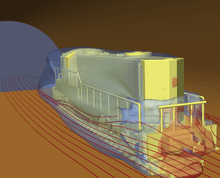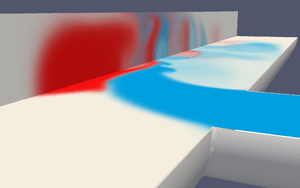Advanced Simulation Library
|
Multicomponent flow simulation | |
| Developer(s) | Avtech Scientific |
|---|---|
| Initial release | May 14, 2015 |
| Stable release |
0.1.7
/ November 9, 2016 |
| Operating system | Unix/Linux, Windows, Mac |
| Type | Multiphysics, Computer-aided engineering, Computational fluid dynamics, Simulation software |
| License | GNU Affero General Public License, optional commercial license |
| Website |
asl |



_method.png)


Advanced Simulation Library (ASL) is free and open source hardware accelerated multiphysics simulation platform. It enables users to write customized numerical solvers in C++ and deploy them on a variety of massively parallel architectures, ranging from inexpensive FPGAs, DSPs and GPUs[1] up to heterogeneous clusters and supercomputers. Its internal computational engine is written in OpenCL and utilizes matrix-free solution techniques. ASL implements variety of advanced numerical methods. Mesh-free, immersed boundary approach allows to move from CAD directly to simulation significantly reducing pre-processing efforts and amount of potential errors. ASL can be used to model various coupled physical and chemical phenomena, especially in the field of Computational fluid dynamics. It is distributed under the free GNU Affero General Public License with an optional commercial license.
History
Advanced Simulation Library is being developed by Avtech Scientific, an Israeli company. Its source code was released to the community on 14 May 2015 whose members packaged it for scientific sections of all major Linux distributions shortly thereafter.[2][3][4][5][6][7] Subsequently Khronos Group acknowledged the significance of ASL and listed it on its website among OpenCL-based resources.[8]
Application areas
- Computational fluid dynamics
- Computer-assisted surgery
- Virtual sensing
- Industrial process data validation and reconciliation
- Multidisciplinary design optimization
- Design space exploration
- Computer-aided engineering
- Crystallography
- Microfluidics
Advantages and disadvantages
Advantages
- Easy to learn C++ API[9] (no OpenCL knowledge required)
- Mesh-free, immersed boundary approach allows to move from CAD directly to computations eliminating pre-processing efforts and reducing amount of potential errors
- High performance, memory efficiency[10]
- Dynamic compilation enables an additional layer of optimization at run-time (i.e. for a specific parameters set the application was provided with)
- Automatic hardware acceleration and parallelization of applications
- Deployment of same program on a variety of parallel architectures - GPU, APU, FPGA, DSP, multicore CPUs
- Ability to deal with complex boundaries
- Ability to incorporate microscopic interactions
- Availability of the source code
Disadvantages
- Absence of detailed documentation (besides the Developer Guide generated from the source code comments)
- Not all OpenCL drivers are mature enough for the library[11]
Features
ASL provides a range of features to solve number of problems - from complex fluid flows involving chemical reactions, turbulence and heat transfer, to solid mechanics and elasticity.[12]
- Interfacing: VTK/ParaView, MATLAB (export).
- import file formats: .stl .vtp .vtk .vti .mnc .dcm
- export file formats: .vti .mat
- Geometry:
- flexible and complex geometry using simple rectangular grid
- mesh-free, immersed boundary approach
- generation and manipulation of geometric primitives
- Implemented phenomena:
- Transport processes
- multicomponent transport processes
- compressible and incompressible fluid flow
- Chemical reactions
- electrode reactions
- Elasticity
- homogenious isotropic elasticity
- homogenious isotropic poroelasticity
- Interface tracking
- evolution of an interface
- evolution of an interface with crystalographic kinetics
- Transport processes
Uses
- ACTIVE - Active Constraints Technologies for Ill-defined or Volatile Environments (European FP7 Project)[13][14][15]
References
- ↑ "ASL - expanding software ecosystem for the DSP/FPGA/GPU market" (PDF).
- ↑ "ASL enters Linux".
- ↑ "ASL for OpenSuse".
- ↑ "ASL for Debian".
- ↑ "ASL for Gentoo".
- ↑ "ASL for Fedora".
- ↑ "ASL for Arch Linux".
- ↑ "ASL among Khronos' OpenCL resources".
- ↑ "Example of an aerodynamic simulation".
- ↑ "Example of an aerodynamic simulation - numerical setup".
- ↑ "ASL deployment: problematic drivers".
- ↑ "About Advanced Simulation Library: hgpu.org".
- ↑ "ACTIVE Project: Intraoperative Brain Shift".
- ↑ "ASL on www.technology.org".
- ↑ "ASL on interestingengineering.com".
